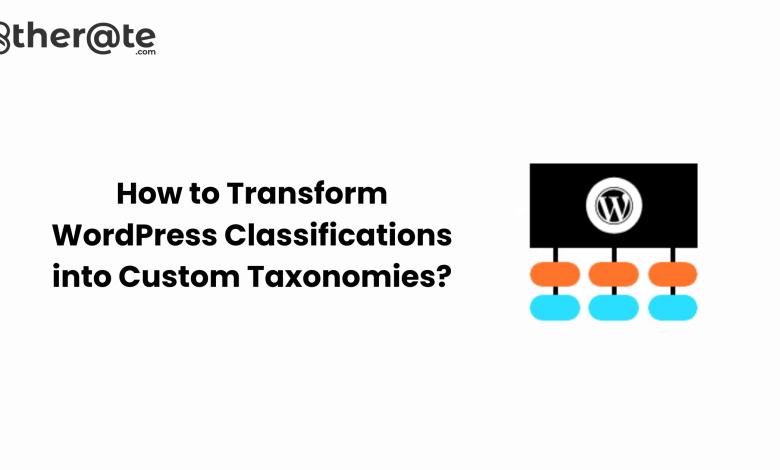How to Transform WordPress Classifications into Custom Taxonomies?

Introduction
WordPress is a versatile and widely-used content management system (CMS) that empowers individuals and businesses to create and manage websites with ease. custom wordpress website development services One of its core features is the ability to categorize and organize content using taxonomies.
Taxonomies allow you to classify content into different groups, making it easier for users to navigate and find the information they’re looking for.
custom wordpress website development services While WordPress comes with built-in taxonomies like categories and tags, there might be cases where you need more specialized classifications.
In this article, we’ll explore how to transform WordPress classifications into custom taxonomies to better structure and organize your content.
Understanding Taxonomies in WordPress
Before diving into creating custom taxonomies, let’s understand the concept of taxonomies in WordPress. bespoke wordpress development In the default WordPress setup, you have two primary taxonomies: categories and tags. Categories are broad classifications that help organize content into major sections of your website, while tags are used to add specific keywords or descriptors to content items.
However, there are scenarios where these default taxonomies might not fully meet your needs.
wordpress development services For instance, if you’re running a recipe website, you might want to classify recipes based on their cuisine type (Italian, Mexican, etc.), which goes beyond the scope of basic categories and tags. This is where custom taxonomies come in handy.
Advantages of Custom Taxonomies
Custom taxonomies provide several benefits for structuring your content effectively:
- Improved Organization: Custom taxonomies allow you to create more refined and specialized classifications for your content, making it easier for users to find what they’re looking for.
- Enhanced User Experience: With custom taxonomies, visitors can navigate your website more intuitively, leading to a better overall user experience.
- SEO Benefits: Properly organized content can have positive effects on search engine optimization (SEO), as search engines can understand your content’s structure more accurately.
- Flexible Content Management: As your website grows, custom taxonomies provide flexibility in managing and expanding your content organization.
Creating Custom Taxonomies
Creating custom taxonomies in WordPress involves a few steps, but the process is well-documented and straightforward.
Step 1: Define Your Taxonomy
Start by defining the custom taxonomy you want to create. wordpress plugin development services Think about the type of classification that would enhance your content organization. In our recipe website example, the taxonomy could be “Cuisine Type.”
Step 2: Add Code to Your Theme or Plugin
To implement a custom taxonomy, you’ll need to add code to your WordPress theme’s functions.php file or create a custom plugin. custom wordpress website development services Using a plugin is recommended, as it keeps your code separate from the theme and ensures that your taxonomy remains functional even if you change themes.
// Example code to register a custom taxonomy
function custom_cuisine_taxonomy() {
$labels = array(
‘name’ => ‘Cuisine Types’,
‘singular_name’ => ‘Cuisine Type’,
// Add more labels as needed
);
$args = array(
‘hierarchical’ => true, // Set to true if the taxonomy should have parent-child relationships
‘labels’ => $labels,
// Add more arguments as needed
);
register_taxonomy(‘cuisine’, ‘recipes’, $args);
}
add_action(‘init’, ‘custom_cuisine_taxonomy’);
In this code snippet, we’re creating a custom taxonomy named “Cuisine Types” for the “recipes” post type.
Step 3: Customize and Display Taxonomy
Once the taxonomy is registered, you can start using it to classify your content. custom wordpress development services Edit your content items and assign the relevant terms from your custom taxonomy. wordpress service provider In our example, you would assign the cuisine type (Italian, Mexican, etc.) to each recipe.
You can also display the custom taxonomy terms on your website using WordPress functions like get_the_terms() and wp_get_post_terms(). This allows you to show the cuisine type on recipe pages, helping visitors quickly identify the type of cuisine.
Conclusion
Custom taxonomies are a powerful feature in WordPress that enable you to create specialized classifications for your content beyond the default categories and tags. custom wordpress website design By carefully planning and defining your custom taxonomies and site development services you can significantly enhance the organization and usability of your website.
Whether you’re running a recipe blog, an e-commerce store, or a news website, custom taxonomies offer the flexibility to adapt WordPress to your unique content structuring needs. custom wordpress website development services With a basic understanding of how to create and implement custom taxonomies, you can take your content management to the next level and provide a better experience for your website’s visitors.









